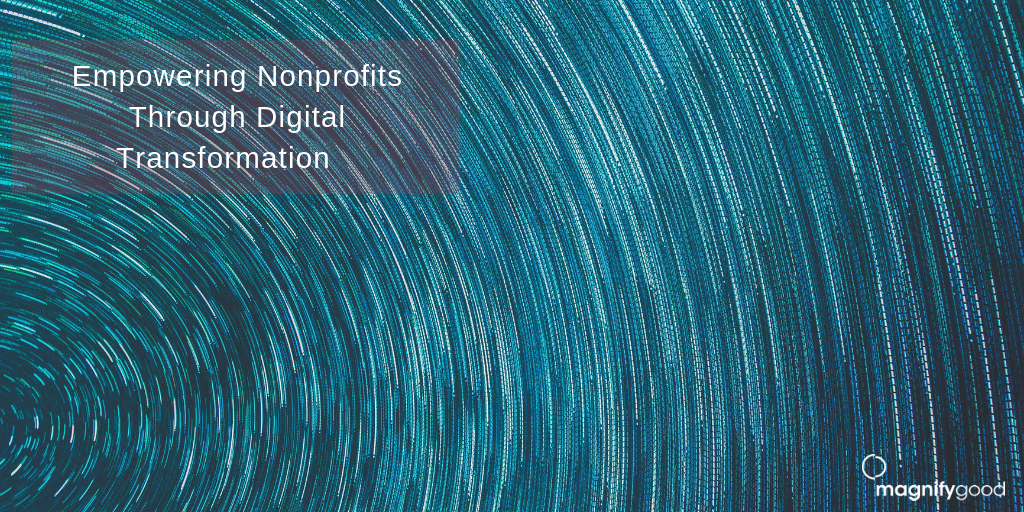Do you remember shuddering at the thought of writing your first blog? What about masking your disdain every time someone suggested that your organization consider online giving? Now, more than a decade later, these tools have become an integral part of the development, fundraising and communications efforts of nonprofits.
Historically, nonprofits have been much slower than the for-profit sector to adopt new technologies and strategies, but we are no longer waiting as the “rise of the digital age” emerges. The digital age is here, and your organization’s success depends on its willingness to adapt to this landscape and embark on the digital transformation for nonprofits.
Nonprofits across the globe are continuously faced with the challenge of solving some of the world’s most pressing problems. Despite the sector’s lack of resources, nonprofits are responsible for reaching new — and retaining current — donors, all while simultaneously increasing operational efficiency. Resource constraints won’t stop your organization from working toward its mission, so how can you increase impact and secure your nonprofit’s success?
The digital landscape has provided nonprofits with a tremendous solution and opportunity to address this challenge. By adopting flexible, robust technology and aligning internal efforts, nonprofits can achieve significantly more without exhausting resources. New technologies can help your organization and its mission thrive, but without a digitally transformative mindset and strategy to use them effectively, they can create problems and frustrations within your organization.
We know you’re likely already using these tools and systems, but your nonprofit’s digital transformation is not simply about adopting new technology. It calls for a complete shift in the way your team thinks and operates, while strategically leveraging technology for impact and efficiency. It requires bringing together people, processes and technology to drive impact through agility and free-flowing systems.
File Sharing
Does your organization use a cloud-based file sharing software? Does it have a folder arrangement set up specifically for your team? Do you have a consistent filing system to mitigate confusion and the potential of losing documents in the cloud? Today, most nonprofits are using some form of digital file sharing software, but poor organization can cause extreme frustration and mismanagement of these systems.
Without a strategic approach to organizing your files and a solidified filing system in place, files can easily become lost, duplicated or accidentally altered beyond repair — unnecessarily creating more work for you and your team.
Project Management
Does your nonprofit still track project progress through drawn whiteboard diagrams — or have you tried to adopt project management software, such as Basecamp, without taking the time to focus on fully integrating or training the team to use it?
This lack of understanding can cause irritation when your nonprofit is attempting to do so much with so little, forcing a sense of defeat and resulting in a system that’s underutilized at a great cost of resources. It’s time that your organization moves beyond simply adopting these systems to becoming experts in their implementation, using them to manage tasks and projects more effectively than it could without them.
Donor Database
Your donor development team is equipped with a database like Raiser’s Edge to manage donor data. But what exactly is going into it? Have you defined the key information you want to capture in your database, along with a deliberate update system to ensure your contacts are saved thoroughly and accurately? Do you have multiple lists of contacts living in different places in your database with duplicate or stale information? Is your development team’s database integrated in a way that allows both your donor development and communications teams to share and benefit from this valuable information?
The lack of coordination results in a duplication of efforts and can cause frustration — both internally and externally. Alternatively, donors can be overloaded by too many competing or even mixed messages during the same time period. Activities can cancel each other out, effectively disengaging a high-potential donor.
Embracing Digital Transformation
In the nonprofit space more than any other, your to-do list continues to grow while resources and time contract. Our world is overwhelmingly digital and while nonprofits have adopted new forms of technology, they have resisted the shift in thinking that is required to leverage these tools the right way for greater mission impact.
Without prioritizing the strategic thinking necessary for your nonprofit’s digital transformation, your efforts will fall flat and likely cause more harm than good. Bringing technology to the center of this strategic thinking and generating higher levels of innovation will result in greater productivity, without compromising resources.
Becoming a truly connected organization doesn’t happen overnight. Putting these strategies into practice takes time, effort and energy. However, taking the time to be strategic with your nonprofit’s digital transformation will pay major dividends in the future — and translate to more good in your world.
photo credit: Derek Thomson via Unsplash




Great post and couldn’t agree more! Something we work hard on for our clients at Submit.com